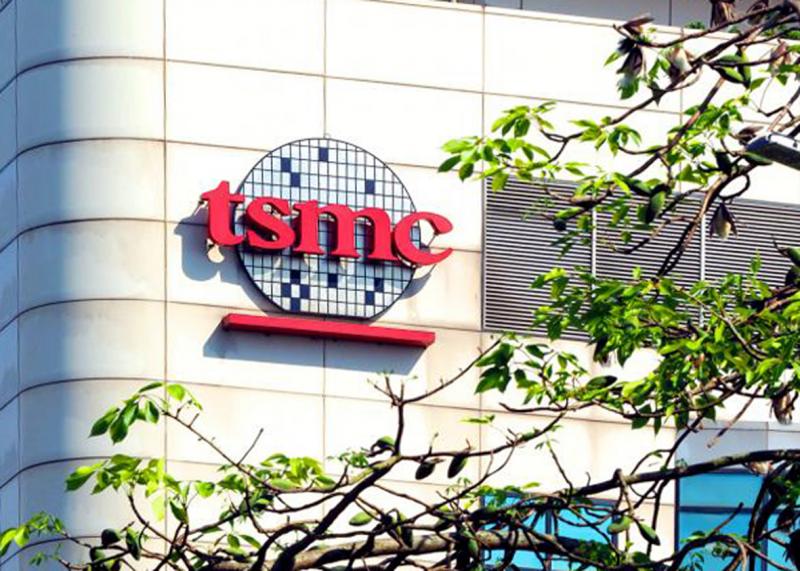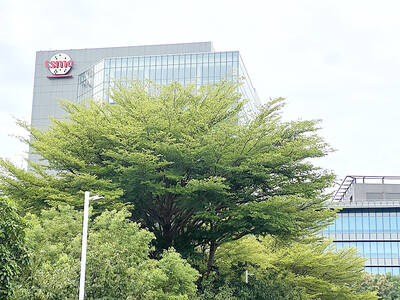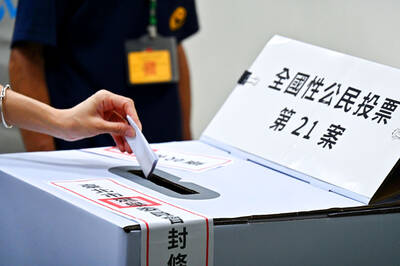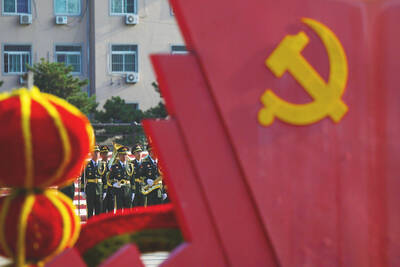Taiwan Semiconductor Manufacturing Co (TSMC, 台積電) yesterday said it is to open a new cutting-edge research-and-development (R&D) center in Hsinchu next year to develop 2-nanometer (nm) technology to secure its technology leadership.
The world’s biggest contract chipmaker said it is also seeking to acquire land adjacent to the new R&D center to build a production fab for 2-nanometer chips.
This is the first time that TSMC has disclosed details about its plans to move into 2-nanometer technology.

Photo: David Chang, EPA-EFE
The company has invested heavily in R&D and advanced capacity, offering 7-nanometer chips in 2018 and 5-nanometer chips this year, with plans to commence volume production of 3-nanometer chips in the second half of 2022, to maintain its edge over competitors such as Samsung Electronics Co.
The 2-nanometer chips are one generation more advanced than 3-nanometer ones.
The new R&D center, dubbed TSMC’s “Bell Lab,” is to house 8,000 scientists and engineers to develop next-generation chip technologies, TSMC senior vice president Kevin Zhang (張曉強) yesterday told an online technology symposium.
It is to be composed of two R&D sections — R1 and R2 — and one office building, the company said.
R1 is under construction and is to become operational next year, Zhang said.
It will serve as the base for TSMC to explore 2-nanometer technology and future generation technologies, TSMC senior vice president Y.P. Chin (秦永沛) said.
TSMC has spent more than US$10 billion a year on expanding advanced technology capacity over the past few years to meet customers’ demand, Chin said.
The investment allowed TSMC to increase its advanced technology capacity at a compound annual growth rate of 28 percent from 2016 to this year, he said.
To cope with robust demand, the chipmaker has continued to expand its 7-nanometer technology capacity, which is expected to be 3.5 times bigger than when it introduced the technology in 2018, Chin said.
The 5-nanometer technology capacity is forecast to grow 1.8 times in 2022, compared with this year’s capacity, he added.
To date, TSMC has shipped more than 1 billion 7-nanometer chips, the company said.
“If you have a 5G phone, most likely the phone is powered by TSMC’s 7-nanometer chips,” Zhang said.
As semiconductor technology is evolving rapidly and becoming increasingly complex, TSMC has been boosting R&D spending to ensure it is able to offer the most advanced technologies to its clients now and for the years to come, Zhang said.
The chipmaker spent US$2.96 billion on R&D last year, up 3.86 percent from 2018, Chang’s presentation showed.
Its R&D headcount also rose to 5,901 last year from 5,609 in 2018, it showed.
Tainan is a major manufacturing hub for the company’s advanced technologies.

CHAMPIONS: President Lai congratulated the players’ outstanding performance, cheering them for marking a new milestone in the nation’s baseball history Taiwan on Sunday won their first Little League Baseball World Series (LLBWS) title in 29 years, as Taipei’s Dong Yuan Elementary School defeated a team from Las Vegas 7-0 in the championship game in South Williamsport, Pennsylvania. It was Taiwan’s first championship in the annual tournament since 1996, ending a nearly three-decade drought. “It has been a very long time ... and we finally made it,” Taiwan manager Lai Min-nan (賴敏男) said after the game. Lai said he last managed a Dong Yuan team in at the South Williamsport in 2015, when they were eliminated after four games. “There is

Taiwan Semiconductor Manufacturing Co (TSMC, 台積電) is expected to start construction of its 1.4-nanometer chip manufacturing facilities at the Central Taiwan Science Park (CTSP, 中部科學園區) as early as October, the Chinese-language Liberty Times (the Taipei Times’ sister newspaper) reported yesterday, citing the park administration. TSMC acquired land for the second phase of the park’s expansion in Taichung in June. Large cement, construction and facility engineering companies in central Taiwan have reportedly been receiving bids for TSMC-related projects, the report said. Supply-chain firms estimated that the business opportunities for engineering, equipment and materials supply, and back-end packaging and testing could reach as high as

POWER PLANT POLL: The TPP said the number of ‘yes’ votes showed that the energy policy should be corrected, and the KMT said the result was a win for the people’s voice The government does not rule out advanced nuclear energy generation if it meets the government’s three prerequisites, President William Lai (賴清德) said last night after the number of votes in favor of restarting a nuclear power plant outnumbered the “no” votes in a referendum yesterday. The referendum failed to pass, despite getting more “yes” votes, as the Referendum Act (公民投票法) states that the vote would only pass if the votes in favor account for more than one-fourth of the total number of eligible voters and outnumber the opposing votes. Yesterday’s referendum question was: “Do you agree that the Ma-anshan Nuclear Power Plant

Democratic nations should refrain from attending China’s upcoming large-scale military parade, which Beijing could use to sow discord among democracies, Mainland Affairs Council Deputy Minister Shen You-chung (沈有忠) said. China is scheduled to stage the parade on Wednesday next week to mark the 80th anniversary of Japan’s surrender in World War II. The event is expected to mobilize tens of thousands of participants and prominently showcase China’s military hardware. Speaking at a symposium in Taichung on Thursday, Shen said that Chinese Minister of Foreign Affairs Wang Yi (王毅) recently met with Indian Prime Minister Narendra Modi during a visit to New Delhi.